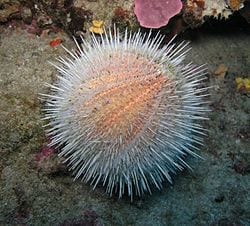The discovery that sea urchins use Nickel particles to harness carbon dioxide from the sea could be the key to capturing tonnes of CO2 from the atmosphere.
Experts at Newcastle University, UK, have discovered that in the presence of a Nickel catalyst, CO2 can be converted rapidly and cheaply into the harmless, solid mineral, calcium carbonate.
This discovery, which is published today in the academic journal Catalysis Science & Technology, has the potential to revolutionise the way we capture and store carbon enabling us to significantly reduce CO2 emissions – the key greenhouse gas responsible for climate change.
Dr Lidija Šiller, a physicist and Reader in Nanoscale Technology at Newcastle University, says the discovery was made completely by chance.
“We had set out to understand in detail the carbonic acid reaction – which is what happens when CO2 reacts with water – and needed a catalyst to speed up the process,” she explains.
“At the same time, I was looking at how organisms absorb CO2 into their skeletons and in particular the sea urchin which converts the CO2 to calcium carbonate.
“When we analysed the surface of the urchin larvae we found a high concentration of Nickel on their exoskeleton. Taking Nickel nanoparticles which have a large surface area, we added them to our carbonic acid test and the result was the complete removal of CO2.”
At the moment, pilot studies for Carbon Capture and Storage (CCS) systems propose the removal of CO2 by pumping it into holes deep underground. However, this is a costly and difficult process and carries with it a long term risk of the gas leaking back out – possibly many miles away from the original downward source.
An alternative solution is to convert the CO2 into calcium or magnesium carbonate.
“One way to do this is to use an enzyme called carbonic anhydrase,” explains Gaurav Bhaduri, lead author on the paper and a PhD student in the University’s School of Chemical Engineering and Advanced Materials.
“However, the enzyme is inactive in acid conditions and since one of the products of the reaction is carbonic acid, this means the enzyme is only effective for a very short time and also makes the process very expensive.
“The beauty of a Nickel catalyst is that it carries on working regardless of the pH and because of its magnetic properties it can be re-captured and re-used time and time again. It’s also very cheap – 1,000 times cheaper than the enzyme. And the by-product – the carbonate – is useful and not damaging to the environment.
The Latest Streaming News: Carbon capture updated minute-by-minute
Bookmark this page and come back often
Latest NEWS
Latest VIDEO








